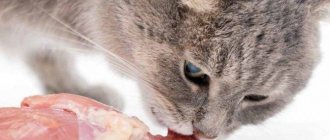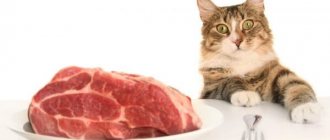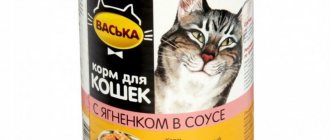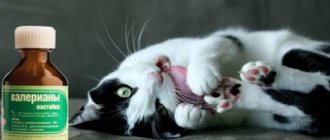Feeding raw meat is a hotly debated topic among cat lovers. Some believe in the benefits, others believe that the potential risks to the pet are not worth it.
However, many veterinarians insist that there is nothing wrong with feeding raw food as long as you have developed a balanced diet. For each individual cat, it is recommended that you consult with your veterinarian to determine the pros and cons of feeding a raw diet. Don't forget to make a list of issues you want to discuss in advance.
Cats with weakened immune systems are more likely to suffer from food-borne diseases. You should tell your veterinarian if you have any medical conditions before putting your pet on a new diet.
What are the risks of feeding a cat raw food?
There are several possible risks, which include bacterial contamination, parasites, internal damage, and not enough or too much nutrients.
Bacterial infection
All meat contains bacteria; however, high levels and certain strains can lead to illness. These include salmonella, E. coli, listeria, clostridia and campylobacter.
Cats have a shorter gastrointestinal tract, which means they digest meat faster. In addition, their stomach secretes large amounts of stomach acid, which breaks down protein and kills bacteria. However, there is always a risk of bacterial contamination from any food, including meat and fresh fruits and vegetables. The precautions listed in this article will help you reduce the chance of infection.
Parasites
Toxoplasmosis Gondii is an intracellular parasite that infects several species of warm-blooded mammals. Cats are definitive hosts, which means parasites can only reproduce in a cat's body. Cats become infected by eating game or meat that contains cysts or the parasite, or by ingesting cysts that are passed through the cat's feces. There are usually no symptoms of this infection, but this particular parasite can cause problems in the baby if the mother becomes infected during pregnancy.
Freezing at -12 for two days kills tocoplasmosis cysts. If you are planning a pregnancy or if you are pregnant, ask your doctor or obstetrician for a referral for an antibody test to see if you have been exposed to the parasite. If you haven't, take extra precautions when feeding your cat raw meat. If possible, have someone else feed her.
Trichinosis is a parasitic roundworm that affects cats when they eat meat contaminated with cysts containing parasite larvae. Most cases of infection occur through eating raw pork or hunting wild animals such as rodents.
Freezing meat for at least 24 hours can kill most parasites. Never defrost meat at room temperature.
Injuries due to bones
Cats that eat bones may experience tooth fractures, perforations, and gastrointestinal obstructions. To reduce the risk, give cats only raw, light bones, never cook them. Chicken necks and wing tips are the best bones for cats.
Taurine deficiency
Tauirn is an essential amino acid found in seafood, meat (mostly muscle, including the heart), eggs and brewer's yeast. When cooking meat, taurine is destroyed due to oxidation. Some cat owners supplement raw food with taurine. An average-sized cat needs about 250 mg of taurine per day. Excess taurine is excreted in the urine. A diet low in taurine can lead to dilated cardiomyopathy and retinal dystrophy.
Secondary nutritional hyperparathyroidism
A diet high in potassium and low in calcium can lead to overactive parathyroid glands, especially in growing kittens. Calcium is an essential mineral needed for the formation and maintenance of bones and teeth, dilation and contraction of blood vessels, transmission of nerve impulses, muscle function, blood clotting, and enzyme function. Bones contain most of the calcium in the body. In the wild, cats obtained calcium by eating the bones of their prey. Ready-made dry food contains enough calcium to meet your cat's needs.
Cats that eat only raw food do not get enough calcium and need supplementation, which is somewhat difficult for owners. Phosphorus is another important mineral that is found in bones and is responsible for their strength, tissue repair, and is also an integral structural component of DNA and RNA. The recommended calcium to phosphorus (Ca:P) ratio is 1.2:1. If phosphorus levels are higher, calcium absorption is impaired. Meat contains high levels of phosphorus but low levels of calcium, so a cat eating only raw, boneless meat (or additives) may have low calcium levels. To ensure the right ratio, you can add raw bones, bone meal, calcium supplements, or crushed eggshells to your cat's diet.
Vitamin A toxicity
High levels of vitamin A are toxic to the liver. An excess of vitamin A occurs if there is a lot of liver in the diet. Vitamin A toxicity can lead to the following:
- Exostotic disease, especially in adult cats. The cervical/thoracic spine and joints are especially affected. Over a long period, complete spinal fusion may develop.
- Loose teeth, gum problems, abnormal bone growth, brittle bones.
- Taking vitamin A during pregnancy can lead to cleft palate.
Vitamin E deficiency
A fat-soluble vitamin known for its antioxidant properties that protect cells from free radicals. Its other functions are strengthening the immune system and reducing inflammation. Vitamin E is found in meat, however, if the diet is dominated by fish, this can lead to vitamin E deficiency.
You can buy special supplements for cats that eat raw food. It is recommended not to buy supplements from China.
Yellow fat disease
This disease is also called panniculitis. This is a painful condition caused by inflammation and yellowing of fatty tissues. This occurs due to eating foods with unsaturated fatty acids, and due to a deficiency of vitamin E, which acts as an antioxidant. When there is an excess of unsaturated fatty acids, fatty deposits are damaged, leading to painful inflammation.
What is important to know when creating a cat menu?
Everyone knows that a cat is a predator. The body of predators is designed so that they can eat raw meat. Cats living in rural areas are great at getting their own food in the summer. Their diet includes mice, lizards, frogs and small birds. They eat mice and lizards without a trace, including the bones, and only feathers remain from birds.
The cat’s digestive system is fully adapted to this:
- sharp teeth and strong jaws allow you to tear off pieces of prey;
- the esophagus is very elastic and easily stretchable, which allows you to swallow large pieces;
- it secretes a sufficient amount of mucus, which helps fairly large pieces of food easily move into the stomach;
- Pepsins are produced in the stomach - enzymes that are necessary for the digestion of proteins. Pepsins break down proteins, and stomach acid digests them;
- The cat's body completely assimilates only protein foods. The cat family almost does not produce the enzymes necessary for processing dairy or plant foods.
In a domestic kitten born in captivity and in a cat that always lives in an apartment, the functioning of the gastrointestinal tract still remains unchanged and does not get used to other food. The gastrointestinal tract cannot adapt and produce other enzymes. If your pet is fed the wrong food instead of meat, it will not be hungry. But he will not receive all the vitamins and microelements necessary for the full functioning of all organs.
It is important to realize that cats are carnivores; their main food is meat.
Benefits of Eating Raw Food
Increased water consumption
Raw food is closest to a cat's natural diet. Modern cats are descended from carnivores that obtained most of their fluids from their prey. On average, 70% water could be obtained, while only 10% could be obtained from dry food. Cats do not always compensate for the imbalance by drinking large amounts of water, which can lead to urine concentration and crystal formation. Males are especially vulnerable because they have a narrower urethra, the passage that carries urine from the bladder out of the body. The narrow urethra of males is easily blocked by crystals or stones, making urination difficult or impossible. This condition is life-threatening and requires urgent veterinary attention.
Improving dental hygiene
Chewing raw meat removes plaque from your teeth. If not removed regularly, plaque hardens into tartar and leads to gum disease.
Weight maintenance
Dry food is rich in carbohydrates; they are stored as fat. Cats need a diet rich in protein, not carbohydrates. Obesity is a growing problem, with 50% of cats in Australia, the UK and the US being overweight, which carries significant health risks.
High taste characteristics
Not all, but a large number of cats prefer the taste and texture of raw food rather than dry or canned food.
Is it possible to feed a cat minced meat?
This is not advisable. The concentration of gastric juice in cats is high: the juice processes the minced meat very quickly - and the product slips through the stomach, as a result of which the beneficial substances do not have time to be absorbed as well as when swallowing pieces. In addition, eating pieces requires effort and time, which allows you to feel full by the end of the meal, while cats may not get enough of pates and ask for more. In addition, jaw work is extremely useful both physiologically and psychologically: it triggers a chain of neuroreactions that promote the development of mental abilities and improve mood - do not deny your cat this pleasure.
Minced meats and pates are served only to cats that have no teeth or are unable to digest pieces (these are sick cats who have appropriate recommendations from a veterinarian). Healthy cats consume meat either in small pieces or large whole pieces. In the second case, they use their teeth to tear off smaller parts from a large piece that are convenient for swallowing.
What raw food can be given to cats?
There are several types of meat that can be given to cats, for example, the shoulder part of a beef carcass is suitable. Ideally, meat should be environmentally friendly and free of chemicals. It is recommended to feed cats the same meat that humans eat. Don't feed your pet the same type of meat all the time; this can lead to nutritional deficiencies. A balance must be maintained: one meal may consist primarily of muscle, another of offal and bones.
Types of raw meat suitable for cats:
- Raw chicken breast or thighs.
- Raw steak pieces. Cheaper pieces require harder chewing, which is good for your teeth and gums.
- Beef or lamb heart and kidneys.
- Beef and lamb liver can be given in small quantities. The liver contains a large amount of vitamin A, and this can lead to intoxication.
- Rabbit meat, cut into pieces
- Turkey breast, wings and legs, cut into pieces.
It is normal to give your cat cooked meat; many owners do so. Never feed cooked bones; they are too fragile and may splinter. As mentioned earlier, cooking destroys taurine, which is essential for cat health. If you choose to feed cooked meat, don't forget to supplement with taurine.
Chicken necks and wings are great for dental hygiene.
Never give your cat meat that has spoiled. And remember that spoiled meat doesn't always look or smell wrong. Always check the expiration date.
Blood for cats
Mostly meat is sold already bled. Of course, some remains, but this is not enough. During the life of the victim, 56% of all blood circulated in its vessels, some was deposited in the liver and spleen, and only 10% was contained in the subcutaneous tissue. When the victim was killed, almost all the blood was drained from him, but it remained in the liver and spleen, as well as in the heart. Therefore, these products serve as a source of blood for the cat.
Blood is a valuable product. It contains that small dose of salt (NaCl) that tailed animals still require. There is a myth that cats do not need salt at all. Needed. Just the amount contained in the products is enough for them. Salt is important for maintaining many vital processes in the body. Therefore, do not pour out or express the drops of blood that remain in the meat after bleeding, but freeze it along with the meat, and after defrosting, carefully pour it into the cat’s bowl.
If you have the opportunity to purchase high-quality blood separately, do not refuse. It also needs to be frozen first if you purchased liquid blood. This is easy to do using ice cube trays. Then take out one cube at a time and add it, defrosted, to the mix. Calculation: 80 ml of blood per 1 kg of meat.
There is also dried blood on sale (so-called blood meal), which can be added to food in pinches. But there is no particular meaning in it, because... it contains proteins that have already been denatured under the influence of high temperatures. On the one hand, the proteins of such blood themselves are absorbed well, however, apart from the protein itself, they do not bring anything useful to the body.
What meat is not suitable for cats?
Processed deli meats such as salami, ham, and turkey lunch meats contain large amounts of preservatives and too much salt.
You can add fish to this list: it can be given in small quantities, but it should not be a constant part of the diet. Fish is high in mercury and low in vitamin E, which can lead to yellow fat disease.
Meat for castrated and sterilized
Spayed and neutered cats and female cats are prone to weight gain
Spayed and neutered male cats have decreased activity and decreased metabolism. They are more likely to gain excess weight. Accordingly, they need less protein. A high protein content in their diet can cause obesity and other diseases of the internal organs. It is necessary to reduce not only the level of protein, but also fats and carbohydrates.
Therefore, the amount of meat in their diet must be reduced and served once a day.
The amount of feed after such surgical interventions is reduced to 150-250 grams per day. At the same time, use lean types of meat about 60-70% of the total diet.
How to reduce risks
It should be remembered that the standards for meat for animal consumption are not as high as for humans, so if you want to introduce meat into your diet, choose the same meat that you eat yourself.
Most nutritionally transmitted diseases occur due to improper storage of meat at home. Be careful when purchasing, transporting, storing and handling raw meat.
- Don't give your cat game: rabbit or kangaroo meat may contain lead fragments, which are very poisonous.
- Homemade minced meat: Minced meat can contain a large number of bacteria, and grinding the meat only multiplies them. If you want to give your cat minced meat, it is recommended to buy a steak, grind it at home and give it to your cat right away.
- Don't Rinse Meat: People usually rinse meat, especially chicken, before cooking, but this is not safe. When rinsing, bacteria spread to nearby surfaces. Instead, pat the chicken dry with a paper towel.
- Buy the meat you eat yourself: find a good butcher who will supply you with meat. Never buy meat if the packaging is bulging.
- Wash your hands: ALWAYS wash your hands with hot water and soap before and after handling raw meat.
- Don't leave meat out: Bacteria multiply quickly in warm environments, so remove and discard uneaten meat after 20 minutes.
- Don't cook raw meats/fruits/vegetables on the same board: you should have separate boards for raw meats and other foods, e.g. fruits and vegetables
- Wash dishes: Wash your cat's bowl, cutting board, and other utensils in hot, soapy water or, better yet, in the dishwasher.
- Storage: Never keep cooked and raw meat on the same plate. Store raw meat on the bottom shelf of the refrigerator to prevent juices from dripping onto cooked meat. Meat in the refrigerator must be properly packaged to avoid cross-contamination.
- Temperature: Store raw meat below 5°C
- Keep an eye on the expiration date: meat must be eaten before the expiration date, find out how long it can be stored in the refrigerator. As a rule, chicken or minced meat is stored for 1-2 days, and beef for three days (unless otherwise indicated in the expiration date).
- Large meals: Freeze meat in smaller portions.
- Thawing Meat: Place in refrigerator the night before to slowly defrost. Never defrost meat at room temperature.
Combining raw and cooked meat
It is not recommended to feed both raw and cooked meat at the same time.
Boiled meat does not worsen the pet's health, but when cooked, meat loses most of its beneficial nutrients. Including the digestion of boiled meat is more difficult for animals than raw meat. Since the cat’s body uses different enzymes and time for digestion to digest cooked and raw meat, feeding both types of meat at the same time will have a serious impact on the stomach.
Feeding raw and cooked meat at the same time is not recommended due to the strain on the pet's digestive system.
Key points
If you are considering transitioning your cat to an all-raw food diet, do your research first. If you want to do it right, you have a lot to learn about cat nutrition. The purpose of this article was to discuss how to properly introduce raw meat into the diet several times a week, but not how to completely transition a cat to a raw diet. There are several benefits to switching to a raw diet, but remember, if you do it wrong, your pet can get very sick.
Many people have switched to raw food only; others prefer a mixed version of raw meat, canned food and dry food. This is a good option because, for example, chewing muscles is good for the teeth, but not nutritious enough, so it is recommended to combine raw meat with dry food.
Based on materials from: www.cat-world.com
How often to feed meat, and in what quantity?
There should be up to 80% of the total diet of meat products per day.
In order to determine the amount of meat products in a cat's diet, it is necessary to take into account factors such as the animal's age, breed, health, activity and even its gender.
Of the total diet of raw meat, adult cats and cats can use 60% to 80% of the total amount of the rest of the food. The remaining percentage of natural nutrition includes vegetables, cereals, offal, including necks, cartilage, animal blood and other products.
That is, meat must be given daily. A pet weighing 5 kg eats about 250 grams of food per day. Of these, more than half should be meat, that is, depending on weight - from 100 to 200 grams per day for a cat is the norm.
Kittens up to one year old are fed four to six times a day. Adult cats can be fed 2-3 times a day.
The meat is served sliced. It is not recommended to feed prepared minced meat. It is allowed to make minced meat yourself. By eating meat fiber, the animal assimilates it better.
In this case, it is advisable to serve offal 1-2 times a week. Liver should be given once a week.
Which dry food to choose for a kitten
For small kittens, as well as for adult cats, several types of food are produced: economy, premium, super-premium and holistic categories. The first two classes are slightly different from each other and contain many grains. This is absolutely not suitable for predators, so such food should not be given to kittens. At a young age, the gastrointestinal tract is finally formed in animals. Any errors in nutrition can provoke the occurrence of chronic diseases. For example, an excess of grains is fraught with the development of diabetes due to the abundance of sources of fast carbohydrates. There is also a threat of pancreatitis due to increased load on the pancreas.
Whiskas is one of the most popular representatives of economy class feeds
It is advisable to give kittens food of the super-premium category or better. Preference should be given to grain-free products: instead of them, small quantities of legumes are used as a source of nutrients. They are better absorbed and contribute to the formation of microflora. Legumes and other plant ingredients should not be at the top of the ingredient list. They serve only as a functional addition, and not as the basis of the menu.
Granules of high-quality dry food should be dark and uniform in shape and size.
In the case of the highest quality food, there may be no division into age categories. The lines of such diets consist of a maximum of 4–5 products, but this is due to their versatility. The manufacturer tries to bring the recipe as close as possible to the natural menu. Since kittens and adult cats eat the same food in the wild, this food is equally suitable for both babies and mature animals.
In this case, you only need to pay attention to the size of the granules: too large ones will be more difficult for the kitten to chew
It is strongly recommended to avoid feeds that contain inaccuracies in the ingredient list. If it is meat, then the manufacturer must indicate the grade. For example, “fresh chicken” is a good ingredient, but the vague name “a mixture of meat derivatives and by-products” should alert you. The latter component may actually represent waste left over from the production of human food. The kitten will receive virtually no nutrients from such a mixture; in addition, the load on the internal organs will increase.
It is necessary to avoid food with multi-colored granules: even if the manufacturer claims that it does not use dyes, such a variety of shades does not matter for cats, but can be harmful
Dry food should not contain potentially hazardous ingredients. These include dyes, flavors and preservatives of unknown origin, as well as sugar. Such components can irritate the mucous membranes of the gastrointestinal tract, which can worsen peristalsis and cause inflammation. In the presence of additional risk factors, the risk of developing pathologies increases significantly.
How to process it?
Raw meat is dangerous because it can introduce parasites into the cat's body. If you do not attach importance to this and do not treat an animal infected with helminths, even death is possible. When we prepare meat for ourselves, we heat it - boil or fry - and this kills the parasite eggs. But fried meat is strictly forbidden for cats, and boiled meat is digested by them much worse than raw meat, it is not as nutritious and not as healthy. What to do?
One of the best ways is to freeze meat. It should be divided into portioned pieces (for one feeding), put these pieces in plastic bags and put in the freezer
You can buy special bags for breakfast, or you can use regular ones, it’s not so important. Plastic vacuum containers are very convenient to use, since there is no risk that they will freeze to each other or to the meat, as often happens with bags
Severe cold can also destroy parasite eggs, which to some extent will protect your purr.
Before each feeding, you will need to remove another bag from the freezer, defrost the meat and give it to the cat. The juice that will be released during defrosting can also be poured into the cat's bowl; many cats love it.
There is no need to make minced meat; it is more convenient for a cat to eat it in small pieces. You can defrost meat in a microwave or microwave oven, then some heat treatment will be added to the freezing.
Natural food or ready-made food
It may seem like why spend time and extra effort to prepare food for cats. After all, there is a huge line of ready-made animal food on sale, from the economy series to the premium class. But how healthy is this food for your pet?
Common inexpensive cat foods contain virtually no ingredients stated on the label. At best, the composition includes meat by-products and soy, which is absolutely not enough for the needs of the animal. But they contain a lot of preservatives and flavorings, which give the food an aroma and taste that is attractive to cats.
Experts do not recommend feeding animals such food for a long time or at least supplementing it with vitamins and mineral supplements.
In feeds of a higher price segment, the content of natural products is much higher. In addition, they already contain vitamins necessary for the animal, and they contain beneficial vitamin E as a preservative. Such food is not only healthy, but also tasty for your pet.
An alternative to these foods can be natural food. Just remember that feeding a cat and eating from the owners’ table are completely different things.
Can a cat eat beef after heat treatment?
It is widely believed that raw meat is harmful to animals due to the risk of infection by helminths and bacteria. Many owners, breeders and even veterinarians still advise processing meat before putting it in a cat's bowl.
Processing is reduced to scalding with boiling water or boiling the beef. However, scalding does not make any sense at all - such a superficial temperature effect is not capable of killing bacteria, not to mention helminth eggs. Boiling meat may be appropriate if you suspect that it is contaminated, that is, it was obtained from a sick animal.
The veterinary inspection that every cow carcass that goes on sale is subjected to virtually eliminates contamination of the meat. A cat may like boiled beef less than raw beef, and there will be less valuable substances left in it. Thus, temperature treatment is not at all necessary.
Beef is an excellent source of protein and fat when feeding cats whose owners prefer to feed at home. But you cannot give an animal only meat; the diet must be tailored to all the needs of the animal and must contain other products and additives.
The importance of meat in the diet
In the wild, raw meat is a basic component of the diet of carnivores. By consuming it, animals provide themselves with the energy they require for full development and growth. Meat is a valuable source of amino acids, which play a decisive role in the formation of muscle tissue. One of the most important amino acids for the cat's body is taurine.
Taurine deficiency leads to deterioration in animal health, blindness, hair loss, and the development of cardiovascular and endocrine diseases. This amino acid is essential for cats, so it must be included in modern food. Products containing vegetable protein are not able to compensate for the lack of substances of animal origin. They are less easily absorbed by the cat's body, so they cannot replace sources of animal protein. In addition, foods rich in plant protein do not contain taurine.
How to cook meat for a cat
To the question of whether a cat can be given raw meat, beef, the answer is yes, but with some conditions. Meat for feeding the animal must first be frozen in the freezer for about two days. This will remove parasites from the meat. Thawed meat should be thoroughly washed and cut into small pieces. Cats are predators; they do not chew their food, but swallow it in pieces; the digestion process itself occurs directly in the stomach. Therefore, the pieces should not be large, two centimeters maximum.
Some experts recommend pouring boiling water over the meat, but this is controversial. After all, in nature, cats hunt and eat raw meat.
If you have doubts about the quality of a meat product or want to diversify your pet’s menu, you can boil it or even stew it. The broth in which the meat was cooked can also be offered to the cat.
The dangers of raw meat products
Unprocessed meat is quite often infected with worms, and they, accordingly, lead to a significant deterioration in the health of the pet. And if the worms are not eliminated with the help of anthelmintics, the disease can cause severe intoxication. Without urgent treatment, acute poisoning ends in the death of the pet.
It is especially dangerous to buy meat with by-products at spontaneous markets. In such places, products, as a rule, do not undergo sanitary control, which is why they may be infected with helminths. In some laboratories, worms are not detected due to the fact that the infection occurred several days or hours before slaughter, and the presence of dangerous parasites was not determined.
The risks of bacterial and helminthic infection are also high in the meat of river fish. It is strictly forbidden to give it to cats. Sometimes even a small piece of fish led to severe parasitic poisoning and even death.
Fish, shellfish, seafood
Many owners stubbornly feed their cats fish and do not pay attention to dozens of arguments that experts give. There is no categorical ban on eating seafood, but there are a lot of nuances and prohibitions. So, a cat can only eat noble varieties of ocean fish. Against the background of the first condition, the fish must be lean, of high quality, boneless and fresh. If all these conditions are met, you can pamper your cat with fish, but not more than once a week!
So, a cat can:
- Lean cod.
- Hake thoroughly cleaned.
- The sardine is lean and fresh.
- Trout only back, provided that the fish is not fatty.
- Boiled shrimp, peeled.
- Boiled chopped squids.
The next nuance is that the fish must be of high quality, which means grown in a clean environment. Almost the entire range of seafood presented on supermarket shelves has nothing to do with the ocean...except for its origin. Shrimp, squid and noble varieties of fish are grown on farms, in cramped “aquariums” generously sprinkled with pesticides, antibiotics and other (harmful) substances. Keep in mind that fish literally absorb the environment (water), and when a lot of fish are placed in one small tank... Simply put, one fish defecates, and the other eats it, and the water in which the future product is located is far from fresh .
Let's return to the prohibitions. Cats should not eat all types of carp fish, since their consumption leads to the destruction of vitamin B1 in the body. Then a chain reaction starts: the liver suffers, the process of blood purification is disrupted, and microelements are no longer absorbed. Visually, you will observe the pet’s depression, poor appetite and neurological disorders: tremors, seizures, convulsions, walking in circles, loss of coordination, etc.
Cats are strictly prohibited from river fish and shellfish. Cannot be eaten either raw or boiled. Even after heat treatment (boiling water), fish can become a source of infection with dangerous types of worms. All helminths are dangerous, but some of them can settle in the liver, brain, and muscles. If river fish is boiled for a long time or canned, the product will be safe, but also useless.
Fish, even permitted and noble varieties, should not be given to a cat often. It just so happens that trimethylamine oxide, which is almost harmless to humans (found in fish), quickly leads to the destruction of iron in the cat’s body. As a result, the animal develops and rapidly progresses iron deficiency anemia.
It is recommended to completely exclude fish from the diet of cats prone to urolithiasis. Regularly feeding a neutered cat seafood will lead to the development of the disease within a few months. If the fish is fed to a cat that is genetically prone to urolithiasis, the disease may take longer to develop. It is not recommended to feed fish to cats of popular breeds, for example, Scottish Fold or British. The fact is that these breeds have quite a lot of ailments that are inherited, but the diseases may not develop until the metabolism is disrupted.
Industrial fish-based foods are manufactured in several stages and are safe for cats. Firstly, the fish undergoes long-term heat treatment, becomes safe and, as mentioned earlier, practically useless. Secondly, the fish is not cleaned, but ground to a homogeneous minced meat and then dried... a powder is obtained. Next, this powder is again subjected to high temperature treatment, fortified and mixed with additives.
After all the manipulations, the fish powder contains only protein and fatty acids... and here there is a nuance. Fatty acids shorten the shelf life of feed, and preservatives, such as ethoxyquin, are used to reduce the rate of their oxidation. The effect of this preservative on the body of cats has not yet been fully studied, but even preliminary findings are very alarming.
Is it possible to give meat to a kitten?
Meat food can be introduced into the diet of kittens when they reach 1.5-2 months. It is better to scrape the fresh product from the main piece and freeze it. You should feed in small portions, starting from 2-3 g, carefully observing the body’s reaction. New foods can trigger diarrhea. You need to start complementary feeding with beef, since this type of meat food is tougher, which promotes chewing skills, strengthening the chewing muscles and massaging the gums. You can give soft rabbit bones and cartilage, chicken necks and wings, pre-cut into small pieces, poultry loin, homemade cheese.
Why is the raw product dangerous?
Pets often become infected with salmonella through this product.
If you give your cat raw meat alone, the following problems may occur:
- Infection with helminths. These are roundworms, toxocara, flukes, trichinella, which cause serious organ dysfunction, even death.
- Hyperparathyroidism. Characterized by deformation and fracture of bones, neurological disorders.
- Bacterial infections. Often diagnosed are salmonellosis or colibacillosis, accompanied by diarrhea and general intoxication.










